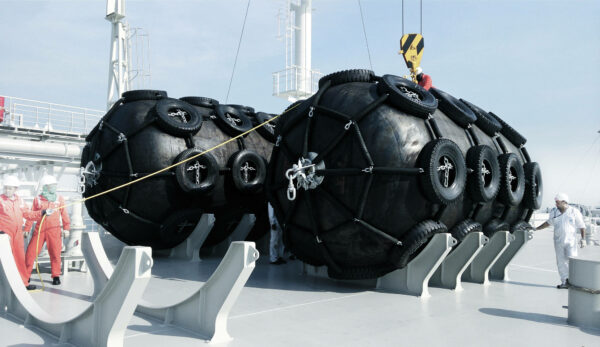Last Updated on November 16, 2022 by PALFINGER
“Fenders are needed by ships and ports all around the globe, not unlike every car has a bumper,” Daniel Løfberg, Global Sales Manager Fenders at PALFINGER MARINE, smiles. Fenders are indispensable in terms of protecting ships and harbors of all sizes – and their equipment – from operational impact and during offshore operations. From yachts to cruise ships, from tugboats to massive tankers, from commercial ports to pleasure harbors – they all need protection from bumps and bruises. Daniel gives an insight into the world of maritime bumpers.
Looking at the PALFINGER MARINE fender range, which products are our strongest asset?
Our best performers certainly are pneumatic fenders, not least due to our long-established, trusted partnerships with customers. We offer the full range of fenders, including foam filled and fixed variants, but some products across all pneumatic categories have developed into firm favorites. From our NPF range, the small versions are usually used as support fenders, while middle-sized fenders are typically utilized on small bunker vessels and tankers. Our large fenders, on the other hand, are perfect for oceangoing vessels and FPSO (floating production and storage and offloading) vessels. Naturally, we also perform excellently in the middle-sized and large segment in combination with our fender davits.
You’ve touched on the various applications of fenders, but could you elaborate by giving us an idea how large the different fenders actually are?
The size of a fender can be chosen in a variety of ways. The objective approach is to analyze one’s needs based on vessel size, energy absorption requirements, and external forces such as weather, sea conditions, and tidal influences. We have highly skilled engineers who assist customers in making these calculations. Our smallest fenders measure 0.5m in diameter and 1m in length, weighing 37kg. They can be lifted by a single person and are perfect for smaller boats such as yachts.
Our biggest fenders are as large as a classic US school bus – 4.5m in diameter and 9m in length. When wrapped in a net, the diameter even increases to 5m, resulting in a weight of 10.6t. These would be used on massive vessels such as ultra large crude carriers (ULCCs) and the aforementioned FPSOs.

New PALFINGER MARINE fenders lifted into their cradles
What exact purposes do the various fender types serve?
Arch, system, fixed, cylindrical, and – at times – pneumatic fenders are ideal for commercial ports, while our foam filled fenders are suitable for pleasure ports. For small contact areas that need to absorb constant working and energy forces, such as a tugboat, rescue vessel, or a support line on the hull of a large vessel, one usually uses strings consisting of fixed fenders. Last but not least, our pneumatic and foam fenders are typically used on vessels that require protection during ship-to-ship (STS) and bunker operations, or for mooring in ports with less-than-ideal berthing areas. In such cases, the fenders are pulled back inboard after the task at hand is completed.
What lends a fender the strength it needs to withstand the power of such massive vessels?
The strength of a fender is measured in energy absorption and force reaction. A great analogy is a pillow: it adapts when you lie down, yet it bounces back once you lift your head. As soon as the forces a fender needs to withstand are determined, you calculate the size and required layers of material. The calculation is made in line with ISO standards and externally verified by the international quality management group PIANC.
As a high-quality supplier, PALFINGER takes these standards and internal testing routines very seriously.
Daniel Løfberg, Global Sales Manager Fenders at PALFINGER MARINE
How long is a fender’s lifecycle?
As long as it is maintained and serviced well, we expect a 10-year lifecycle. The nature of rubber, foam, and other materials used for fenders means that the product degrades over time and ultimately bursts. That is why quality is so important for insurers and clients trusting that the fenders in use actually protect their assets. A fender is basically a big balloon with a relief valve that protects its integrity when stress levels are too high or a big pillow that cushions impacts. Netting and tires, which are fairly easy to replace, can extend the lifecycle.
What can PALFINGER MARINE offer those looking for high-quality fenders?
PALFINGER offers stock fenders in various sizes out of all our branch offices including Singapore, Dubai, Rotterdam, Husøy, and more. In the first three mentioned branches, we also rent out standard-sized fenders on long- and short-term contracts. It goes without saying that our service team for fenders and davits operates on a global scale.
We at PALFINGER MARINE are committed to quality and continuous innovation in the fender segment. We know how valuable our customers’ assets are and make it our business to protect them accordingly.
